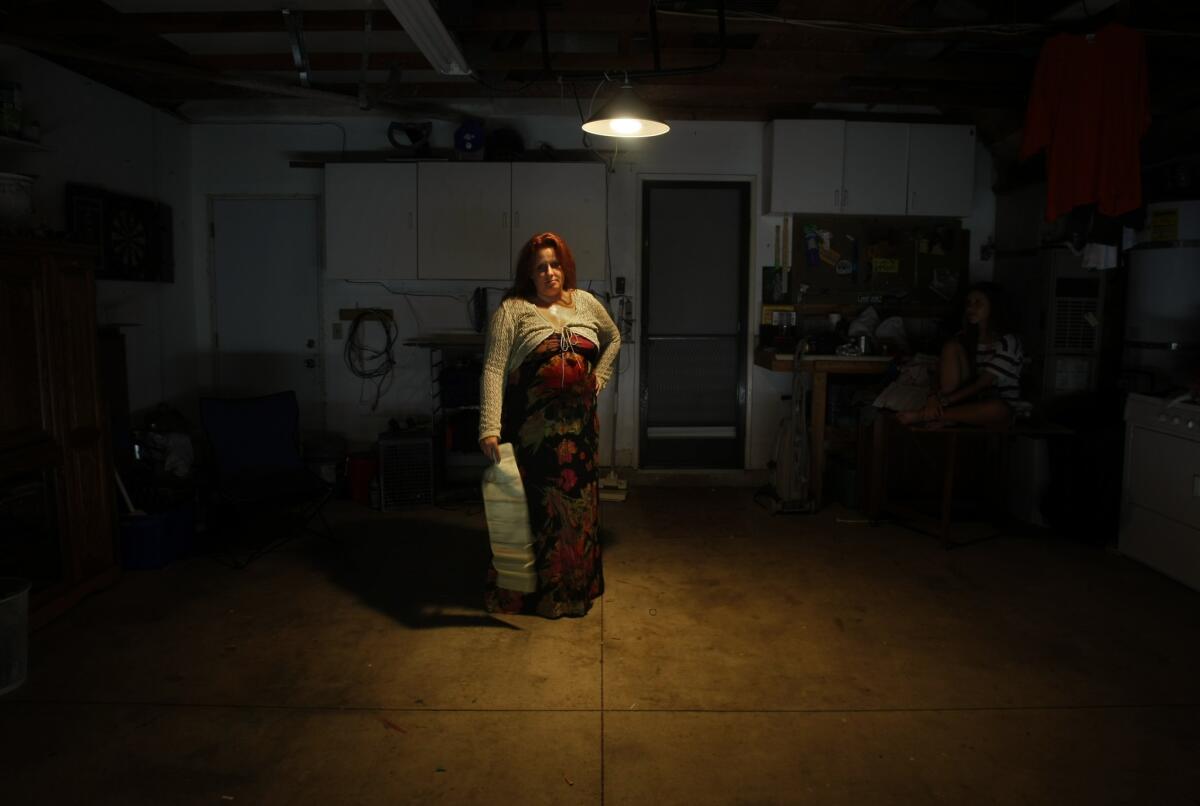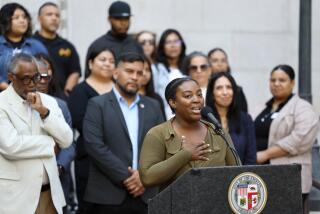A hard road for the poor in need of cars

No car, no work.
That’s the conclusion Lisa Twombly reached as she fought to hang on to her job as a caretaker for an elderly San Diego couple. Taking the bus and bumming rides from friends wasn’t cutting it, and she was repeatedly late for work.
Told she’d be fired if it happened again, Twombly put down $4,000 — all her savings — on a 9-year-old Chrysler Sebring with 95,000 miles. The dealership lent her the $2,600 balance at a steep 18% interest rate.
A few months later, the Sebring broke down and she got into a dispute with the dealer over who should pay for repairs. Twombly quit making loan payments, and Dig’s Wheels of Escondido, Calif., repossessed the car.
She again struggled to get to work on time and was fired. That set off a chain of events that left the 38-year-old single mother and her two children homeless for six weeks. “I don’t know what I’m going to do,” said Twombly, who is still out of work. “I lost my job because I lost my car.”
For more than a century, efforts to help the disadvantaged have focused on education, healthcare, nutrition and housing. Almost nothing has been done to help the working poor afford cars, despite research that indicates it would help alleviate poverty.
About 1 in 4 needy U.S. families do not have a car, according to the Annie E. Casey Foundation. That’s a serious handicap for the millions of Americans who don’t have access to robust mass transit.
A nationwide survey of 353 people who bought cars with help from a nonprofit group called Ways to Work found that 72% reported an increase in income. Of those who were on public assistance when they acquired a car, 87% were no longer receiving it a few years later.
Other studies have found that low-income people were more involved in community activities and had better access to healthcare after getting cars, while their children participated more frequently in after-school programs.
“You’re more likely to have a job and less likely to be fired,” said Evelyn Blumenberg, a professor of urban planning at UCLA who studies transportation and poverty. “It’s just a no-brainer that low-income families need cars.”
Yet there are almost no state or federal programs to meet the need.
The U.S. Transportation Department plans to spend $71 billion this fiscal year on roads and bridges, $22 billion on public transit and more than $8 billion on rail projects, but has allocated no money to help put the poor behind the wheel.
Under the Community Reinvestment Act, the Federal Reserve encourages banks to provide loans to struggling farmers, disadvantaged people hoping to buy homes and small businesses that want to expand — but not to people who need cars to work.
If anything, the government has hindered the working poor’s access to cars. The 2009 Cash-for-Clunkers program, for example, put 690,000 running vehicles in the junkyard, making the used cars that remained more expensive.
“Those cars could have been used for very needy working-class families,” said Carolyn Hayden, a Glendarden, Md., transportation consultant. “It will go down in the annals as a missed opportunity.”
The lack of alternatives drives millions of families into the arms of Buy Here Pay Here dealers, known for selling used cars at stiff markups and with high-interest loans. Many of the buyers eventually default, and the dealers repossess the vehicles and often put them back up for sale. Dealers sometimes sell the same car again and again.
The Buy Here Pay Here industry has prospered during the economic downturn, selling to people whose incomes and credit ratings have taken a hit. Dealers say that they are meeting a societal need and not just squeezing profits from people who are down on their luck.
“If we don’t finance these people, they have no way to get to their job,” said Ken Shilson, founder of the National Alliance of Buy Here Pay Here Dealers in Houston. “Our dealers are providing a service no one else will.”
Andrew Digerness, the Buy Here Pay Here dealer who sold Lisa Twombly her car, declined to talk about details of her repossession. But he said he gives customers a three-month grace period before taking back their cars, and that only 5% of his loans end in default.
“I don’t like to repo,” Digerness said. “But there are certain customers that don’t have a grasp of reality.”
There are alternatives to Buy Here Pay Here lots, but not many.
About 160 nonprofit groups nationwide focus on providing affordable used cars to needy families. None is in Southern California, although some churches and other nonprofits provide used cars as part of broader charitable efforts.
The dedicated used-car programs work in different ways. Some receive donated vehicles. Others buy cars at auction, using private donations or public funds. Recipients are given cars outright or are allowed to purchase them with reduced-rate loans.
Nicole Toenies, a 28-year-old single mother, bought her car through one such program, JumpStart Auto, after she tired of making repairs to the 15-year-old Ford Explorer she’d bought from a Buy Here Pay Here dealer.
JumpStart operates a not-for-profit used-car lot serving rural communities in western Wisconsin. It gives qualified buyers up to $1,000 for a down payment and arranges low-interest loans for the balance. Over the last decade, the program has sold cars to 340 people.
Toenies used to pay $212 a month on the Explorer. She now pays $182 a month for a 2007 Pontiac G6 that is more reliable and uses less gas; $20 from each payment goes into a repair fund.
The modest reduction in the loan payment has made a big difference.
“It’s a phone bill, it’s gas money,” said Toenies, who was unemployed when she got the Pontiac and now drives it to her job designing children’s clothes for Kohl’s. “It’s been a lifesaver for me.”
Ways to Work in Milwaukee, among the nation’s largest such programs, has offices in 20 states and finances about 1,400 auto sales a year.
It makes auto loans at 8% interest to people with low incomes and poor credit scores. Borrowers must be parents, and are required to complete a financial counseling course before being handed the car keys.
Only 1 in 10 loans ends up in default, said Jeff Faulkner, president of Ways to Work. In contrast, 25% of buyers default on loans made by Buy Here Pay Here dealers, according to the industry trade group.
A 2006 survey of 108 low-income car ownership programs found that they distributed about 10,000 cars a year combined. Buy Here Pay Here lots sell nearly 2.4 million cars a year, according to CNW Marketing Research.
“It’s not even a drop in the bucket,” Faulkner said of programs like his. “The system just isn’t set up for these people to succeed. There should be a Small Business Administration or Federal Housing Administration for cars.”
Rep. Gwen Moore (D-Wis.) has tried for years to get the government to help the poor buy cars. In 2005 and again in 2007, she sponsored legislation to provide $50 million a year for low-income car ownership programs. Both bills died in committee.
She said she has faced resistance from, among others, environmental organizations that insist mass transit is a better solution.
“Public transit is not practical in Milwaukee where the wind chill can be 45 below and you have to drop three kids off at day care,” Moore said. “We really have a crisis with respect to getting people to their jobs.
In many states, welfare laws limit what aid recipients can spend on cars. In California, they can’t own a car worth more than $4,650, a dollar value set in the mid-’90s.
That forces people to choose: buy a clunker, or go without a car to remain eligible for public assistance. This month, Gov. Jerry Brown vetoed a bill to lift the cap, citing concern over its potential effect on the state budget.
The bill’s author, Assemblyman Roger Hernández (D-West Covina), said the veto was misguided.
“Let’s remember that California is a highway state, and having a reliable car is a key component in helping an individual find and retain a job,” he said.
Gilbert Perez would love to have a car. He spends two to four hours a day commuting to work by bus and rail from his apartment in downtown Los Angeles. A janitor who cleans apartment buildings, he goes to a different site every day, from San Pedro to Newport Beach to Yorba Linda.
On a hot summer afternoon, he caught the crowded No. 40 bus near his downtown apartment on his way to the South Bay. The bus headed west on Martin Luther King Jr. Boulevard before turning onto Crenshaw Boulevard and lumbering through Leimert Park, Inglewood and Lawndale. Perez grimaced as the bus growled and swayed.
“MTA, OCTA, Amtrak, Blue Line, Red Line, Green Line — I ride them all,” Perez said. “I had a car once, but I couldn’t afford it. I sure wish I could.”
Not long ago, Stacy Gunter was in a similar situation.
A 25-year-old single mother without a job, she was trying to attend a two-year nursing program in a town 45 minutes from her home in Charleston, W.Va., but she had no car.
Every night, she would call friends trying to finagle a ride, and within weeks she had missed several days of class. Swallowing her pride, she applied for Medicaid and food stamps. Then she heard about a low-income car ownership program called Good News Mountaineer Garage, which sold her a 6-year-old Mazda in good condition for $1.
Thanks to the car, Gunter said, she was able to finish school and get her first job as a nurse in 2003. Today she’s married, owns a home and is finishing a master’s degree in nursing from Vanderbilt University.
“Having that car changed the course of my life,” Gunter said. “I only wish there were a program like that everywhere.”
Part One: A vicious cycle in the used car business
Part Two: Investors place big bets on Buy Here Pay Here used-car dealers
More to Read
Inside the business of entertainment
The Wide Shot brings you news, analysis and insights on everything from streaming wars to production — and what it all means for the future.
You may occasionally receive promotional content from the Los Angeles Times.










